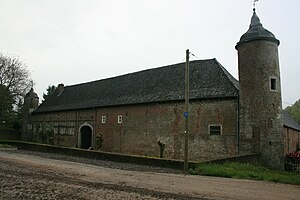House Ober-Frohnrath
| House Ober-Frohnrath | ||
|---|---|---|
|
Ober-Frohnrath Castle |
||
| Castle type : | Niederungsburg | |
| Conservation status: | Castle building from the 16th / 17th centuries Century | |
| Place: | Aachen-Horbach | |
| Geographical location | 50 ° 50 '45.1 " N , 6 ° 2' 14.3" E | |
|
|
||
House Ober-Frohnrath (in old sources also Fronerothe or Vroenrade ; in more recent publications also Oberfronrath ) is a medieval aristocratic seat and a former cologne fiefdom on Katzenpolsweg 6-10 in Aachen . The building is located north of the village of Horbach on the northern border of the Richterich district .
history
The first mention of Ober-Frohnrath can be found in the yearbooks of Klosterrath ( Annales Rodenses ). These mention Ober-Frohnrath in 1112 as the Fronerothe house in the parish of Richterich .
Originally the rectangular complex had a stately apartment, a consecrated chapel and four towers, of which only the two on the street front have been preserved today. At the end of the 19th century it was surrounded by water on two sides. The house consisted of 293 acres of land, in the middle of which the house was located.
At the time of the Archbishop of Cologne Engelbert II von Falkenburg , Ober-Frohnrath came to Kurköln along with other goods in the Falkenburger and Limburger Land . Since the 14th century, these goods including Ober-Frohnrath were then under the Electoral Cologne Lehnskammer zu Heerlen .
In the 15th century the Hove van Overstvroinraide was owned by Roland von Obbendorp. In 1477 Ober-Frohnrath belonged to the Jülich Hereditary Marshal Johann Hurth van Schoeneck to Ringsheim Castle and his wife Johanna von Birgel. In 1524 Junker Doin , Herr zu Frankenberg , received the estate as a fief. The Doin named was Adam von Merode-Frankenberg, who, in addition to the Frankenberg Castle, also held the bailiwick of the Burtscheid Imperial Abbey . His heir daughter Elisabeth von Merode called Frankenberg (documented 1540–1577) married Hermann von Buer (documented 1527 - † approx. 1562) zu Böckum , Rommeljans and Kastein from the von Buer family . In 1540 Hermann shared the inheritance of his in-laws with other heirs. Hermann and Elisabeth received 500 gold guilders and Ober-Frohnrath ( Hoff Erve ende Goet zu Vroenrade ), which the couple leased.
Hermann's great-grandson Johann von Buer (1609–1647) and his wife Maria von Scheidt called Weschpfennig (1604–1677) sold the Ober-Frohnrath farm in 1637 to the Imperial Colonel Gottfried Freiherr von Friesheim and his wife Katharina Amya. Gottfried von Friesheim was still a feudal man from the Electorate of Cologne in 1681. In 1738 Ober-Frohnrath was sold to the Aachen citizen -captain Johann von Thenen. He bequeathed the house to his descendants, who still owned it in 1885. The estate has now been in the hands of the Hogen family for many decades.
The present-day, listed, four-wing building stock comes from the 16th and 17th centuries. The north wing bears the year 1646. The castle was renovated in the 20th century.
literature
- Dietmar Ahlemann: The Lords of Buer - A West German Family History from the High Middle Ages to the 19th Century. In: West German Society for Family Studies eV (Ed.): Yearbook 2012, Volume 274, Cologne 2012, pp. 213-300.
- Bernhard Gondorf: The castles of the Eifel and their peripheral areas. A lexicon of the "permanent houses" . J. P. Bachem, Cologne 1984, ISBN 3-7616-0723-7 , p. 18 .
- Anton Heusch junior: News about the Ober-Frohnrath estate. In: Journal of the Aachen History Association . Vol. 7, Aachen 1885, pages 295-298.
- Karl Emerich Krämer: Castles in and around Aachen , Mercator-Verlag, 1984.
- Christian Quix : The Frankenburg, commonly called Frankenberg and the Vogtei over Burtscheid , Aachen 1829.
- Christian Quix: Bernsberg Palace and Chapel , Aachen / Leipzig 1831.
- Heribert Reiners (arrangement): The art monuments of the districts of Aachen and Eupen. In: Kunstdenkmäler der Rheinprovinz, Vol. 9 II, Düsseldorf 1912.
Individual evidence
- ↑ Heusch (1885), page 295
- ↑ Heusch (1885), page 295.
- ↑ Heusch (1885), page 296.
- ↑ Heusch (1885), page 296.
- ↑ LHA Koblenz, Order 54 32, certificates 200, 201, 203, 208 and 236.
- ↑ A copy of the certificate of inheritance can be found in Quix (1831), page 163 ff.
- ↑ Reiners (1912), page 499 (133).
- ↑ Heusch (1885), page 296 f.


